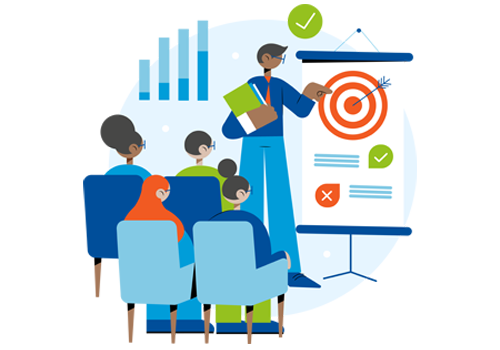| IN THIS ARTICLE |
|
1. The importance of identifying training needs 2. How will a training needs matrix help? 3. The ideal how-to to start with a training needs matrix 4. So when do I start Matrix training needs analysis? |
The importance of identifying training needs
If you look at it in simplest terms, training requirements would, for most businesses, fall into two categories. Statutory requirements and internal requirements.
Along with other variances, the requirements for different roles might require training demands such as time or even geographical challenges. Some obligatory training may need to be executed at different times of employment, to allow for this. As an example, Driver Training for a trucking company employee may be needed only every five years to satisfy compliance requirements, but your internal policy requires a Defensive Driving Course to be completed every two, as a term and condition of employment.
It is important to know and incorporate all training requirements for every employee, before beginning to organize and structure individual training. This is where a Skills matrix will come in handy. But, how exactly?
How will a training needs matrix help?
Know at a glance. One look at who is at what stage of their training, both current and ongoing is a pretty attractive possibility.
A Skills matrix will have the ability to provide information on skills and competencies required for the role as individuals, and at a team level. One feature of having a matrix of this kind is that it may identify the gaps in training that need to be addressed as a priority. This can also be at a team level as well as an individual level. Another and perhaps to some, the best feature of a matrix is the ability to analyze not only the needs of the employee but the needs of the business.
Analysis can be multilevel, but some of the more common reasons to analyze training are the following.
Performance analysis. Is an employee meeting the expectations of their superiors, their colleagues, or the terms of employment? Can further training or more competency bases courses change the performance of the individual? Content analysis. Is the training applied really needed for that role? Some training may be superseded or redundant for that particular occupation.
Another reason for analysis is simply for training suitability. There are many issues concerning employee relations, attitudes, and performance problems in the workplace today. A Skills matrix can provide or point to certain training as a solution for such issues. As the supervisor of any training, a review can be undertaken to ensure the current obligation of employment, and the expectation of the employee of you as an organization. A Skills matrix can only assist to build confidence in knowing the skills required for all roles are being met on a regular basis, and without discrepancies in commitment by either party.
The ideal how-to to start with a training needs matrix
Gather all your information. Ensure you have a knowledge of all the roles that will be included in your matrix. It is necessary to have a few things in order to get the most out of your Skills matrix.
Firstly, and probably the most important is to assess the requirements for each role. As mentioned previously, sometimes this can be at an organizational level, and sometimes it will be from compliance obligations. Of course, it may be both. Partner with a solution architect and infrastructure if you cannot see a way forward to implementing these kinds of things without assistance.
Having software can increase not only the accuracy of training completed and imminent, but also increase the amount of time you have to focus on other equally important projects. The reliability of the information you and others involved are viewing will also be apparent. One thing certain is that the skills of your employees need to be current and ongoing. This will ensure their ability to match, identify and reduce the current competitive challenges every industry faces.
Having the right analysis in place will help you to get the right insights for your organization.
So, when do I start matrix training needs analysis?
This is a guide to get you started. Your Skills matrix can be as simple or as complicated as you like, or as to meet your organization’s needs. If this is new to you, keep it simple to start with. You can always add more to the matrix as your employees and your needs and obligations grow.
You might also like...
Resources
Filter articles
- Blog
- eQMS
- GDP Logistics
- News
- Digital HSE
- Document Control
- Training Management
- Digital Transformation
- Incident Management
- Risk Management
- Videos
- Webinars
- Audit Management
- Complaint Management
- Safety Management
- White papers
- CAPA Management
- Features
- Hazardous goods
- ISO certificates
- Inspections
- Materials management
- Pharma
- VCA
Whitepaper
Taking stock
This is your business. It only makes sense that you monitor supplier quality standards, with a view to an issue-free future. Don’t take risks with your business that will have a definite, undeniable effect on your customers. If you’re wondering what the big deal is, this is about achieving your organizations objectives.
Your suppliers have made an undertaking either by a formal agreement or through an ongoing relationship, to become a working partner in your business. Enormous amounts of time and money have been expended with a view to success for both parties.
What most people forget is that it takes hard work coupled with due diligence to maintain that success. Complacency is a dirty word.

